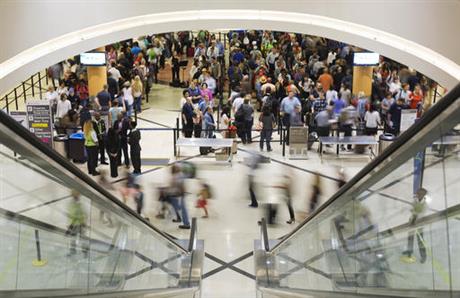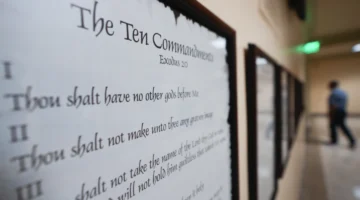What to know about long lines at airport security
NEW YORK (AP) — Fliers should brace for long waits at airport security over the holiday weekend. In recent weeks, some major airports saw wait times exceeding 90 minutes at peak hours, and passengers missed flights waiting to get through security.
There have been encouraging developments in the last few days. After Chicago officials threatened to privatize security at the city’s two big airports, the Transportation Security Administration moved dozens of part-time screeners to full-time and brought in more canine units to sniff passengers for explosives.
Waits at Chicago’s O’Hare Airport — one of the most delay-plagued in the nation — have shrunk to around 15 minutes, according to an American Airlines spokeswoman. A Baltimore attorney tweeted Tuesday that he got through the expedited security line there in 10 minutes. The deluge of photos posted on social media sites with the #iHateTheWait hashtag slowed to a trickle.
Still, Homeland Security Secretary Jeh Johnson says the average wait time nationally is about 30 minutes and about five minutes for expedited PreCheck lines. And that is before the unofficial start of summer.
Here’s a look at the problem and what travelers should expect.
Q: Why have the waits been so long?
A: More people are flying, thanks to a mix of a strong economy, more flights and lower fares. At the same time, the Transportation Security Administration needs more screeners. The TSA and Congress cut the number of screeners by 10 percent on expectations that an expedited screening program called PreCheck would speed up the lines. However, not enough people enrolled. The TSA had been randomly placing passengers into the faster PreCheck lanes under a program dubbed “managed inclusion,” but that stopped in the fall after government auditors found lapses in security.
Q: Will there be long lines for my flight?
A: Right now it’s hard to tell. The airline industry has criticized the TSA for a lack of up-to-date information — you can readily find information on highway traffic delays but not delays in airport security lines. A TSA spokesman says the agency will post current wait times by mid-June. The worst waits have been at the largest airports during peak hours. But during slower hours, the TSA staffs fewer lanes and that might cause backups. The TSA suggests passengers arrive at least two hours before domestic flights but some in the airline industry are now saying to allow even more time.
Q: What is the government doing about it?
A: Congress agreed to shift forward $34 million in TSA funding, allowing the agency to pay overtime to its existing staff and hire an extra 768 screeners by June 15. But there is no grand plan to return staffing to former levels. Some passengers can still randomly be placed in PreCheck based on their age or if an explosive-detecting dogs first screen them, but those are small numbers. The TSA is relocating screeners and canine teams to the 20 busiest airports, such as Chicago’s O’Hare.
Q: What are the airlines doing to help?
A: American Airlines and United Airlines all say they are spending $4 million each to bring in contract employees who can take over non-screening chores such as handling bins and managing lines, freeing up TSA agents to focus on screening. A spokesman says Delta Air Lines will spend between $3 million and $4 million and is also redesigning two checkpoint lanes at Hartsfield-Jackson Atlanta International Airport to speed things up before Memorial Day.
Q: What can I do to speed up the line?
A: Don’t carry a bag on the plane if you can avoid it. TSA Administrator Peter Neffenger told a congressional hearing Wednesday that the large volume of carry-on bags has put extra pressure on screeners. Whether carrying on a bag or not, each passenger should have their ID and boarding pass ready. Before reaching the X-ray machine, empty your pockets and place your keys, cellphone, change and any metallic jewelry into your carry-on bag. Wearing slip-on, slip-off shoes also helps.
Q: What if I miss my flight?
A: For now, airlines have been finding space for them on later flights. But on the busiest travel days there are very few empty seats to accommodate anybody who misses a flight.
__
Koenig reported from Dallas.
Follow Scott Mayerowitz at twitter.com/GlobeTrotScott . His work can be found at http://bigstory.ap.org/content/scott-mayerowitz .
Follow David Koenig at http://twitter.com/airlinewriter



No Comment